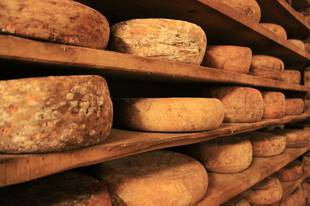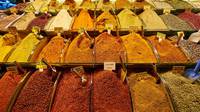
Cheese is one of the most varied and fascinating of dairy products. In its most basic form, cheese is the curdled milk of sheep, goat, cows, or other mammals. Cheese can be found in a wide range of incarnations, from soft curds of farmer's cheese to the much harder Parmesan, which also includes a hard rind achieved by long curing. Cheese is used in a dazzling array of culinary applications, with various types of cheeses being called for depending upon the desired effect.
To make cheese, rennet, an enzyme complex produced in the stomach of all mammals, is introduced to milk. Most rennet comes from the stomachs of calves, although rennet from other young mammals is also used. Non-animal sources of rennet are available for vegetarians and those observing kosher diets. Rennin is the active enzyme in rennet, and when introduced to milk, it causes it to separate into solid curds, leaving whey behind.
After the curds have formed, they are drained and pressed to separate them from the whey. Loosely packed curds, also called cottage cheese, are eaten across much of the world. Cottage cheese contains a small amount of whey, because it is not fully drained. Usually, curds are drained and pressed repeatedly to squeeze all the water out. As they start to firm up, the curds turn into fresh or farmer's cheese, which is a soft and easy to spread cheese product with a mild flavor. Farmer's cheese is delicious eaten fresh. Chevres, Neufchatel, and Cas are all examples of fresh cheeses. Fresh cheeses spoil quickly, even when refrigerated, unless heavily preserved.
After being pressed dry, the curds are packed into a mold and weighted. This is where the magic of the cheese begins, because depending upon the diet of the animals used to produce the milk, milk fat content, pasteurization, ambient molds and bacteria, and ripening time, dramatically different cheese products can be produced. The molded cheese can be brined, as is the case with feta, or treated in other ways for a desired flavor. Flavors can also be introduced by smoking, soaking in wine or another liquid, or adding herbs and spices to the curds
The longer a cheese ages, the more flavor will develop. Most cheeses are highly acidic, and therefore will kill any harmful bacteria while allowing flavor-imparting molds to remain. Some molds are only found in very specific regions, or even in certain cheese caves, meaning that a wide range of cheeses can be produced all over the world.
The possibilities for cheese are literally endless. In some cases, governments have protected their heritage cheeses by applying for origin appellations, meaning that only specific cheeses can bear a regional name. Cheese must be aged in the Cambalou caves of France and contain Penicililum roqueforti to bear the Roquefort name, for example.


















